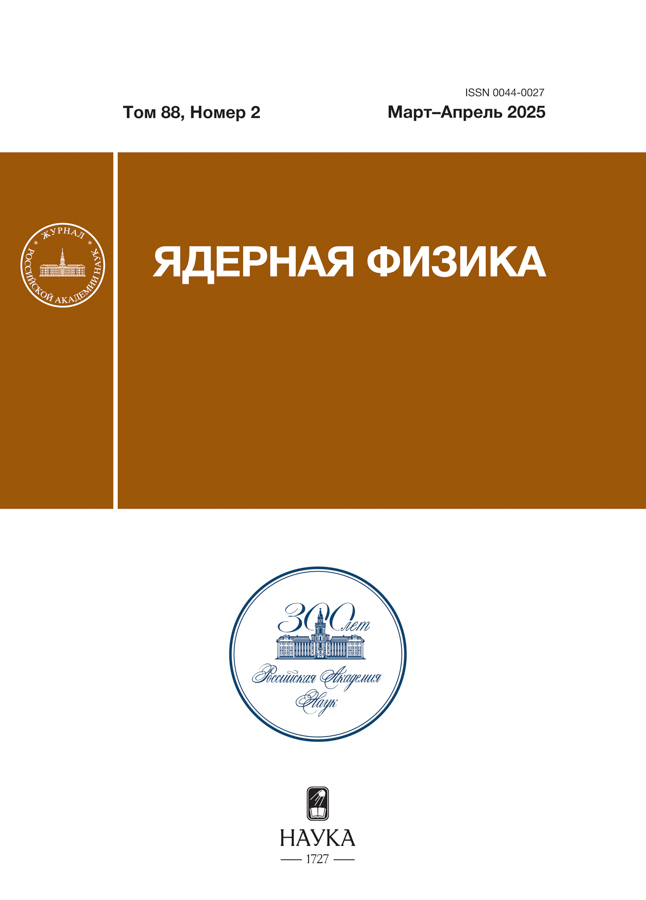Особенности форбуш-понижений по данным спутниковых и наземных детекторов
- Авторы: Лагойда И.А.1, Воронов С.А.1, Михайлов В.В.1
-
Учреждения:
- Национальный исследовательский ядерный университет “МИФИ”
- Выпуск: Том 87, № 2 (2024)
- Страницы: 86-90
- Раздел: ЭЛЕМЕНТАРНЫЕ ЧАСТИЦЫ И ПОЛЯ. Эксперимент
- Статья опубликована: 07.10.2024
- URL: https://cardiosomatics.ru/0044-0027/article/view/674660
- DOI: https://doi.org/10.31857/S0044002724020036
- EDN: https://elibrary.ru/KRVVZK
- ID: 674660
Цитировать
Полный текст
Аннотация
Форбуш-понижения проявляются в виде резкого уменьшения интенсивности космического излучения, регистрируемой широким спектром наземной и спутниковой аппаратуры. Природа данного явления тесно связана с корональными выбросами масс — турбулентными процессами, происходящими в солнечной атмосфере. Корональные выбросы масс, распространяясь в межпланетной среде, воздействуют на частицы космических лучей, выметая их из области модуляции, что и проявляется в виде эффекта, известного сегодня как форбуш-понижение. В настоящей работе изучены особенности поведения временных профилей интенсивности космических лучей во время форбуш-понижений от жесткости частиц с использованием данных по потокам космических протонов, зарегистрированных спектрометром АМС-02 в период с 2011 по 2019 г.
Полный текст
Об авторах
И. А. Лагойда
Национальный исследовательский ядерный университет “МИФИ”
Автор, ответственный за переписку.
Email: IALagoida@mephi.ru
Россия, Москва
С. А. Воронов
Национальный исследовательский ядерный университет “МИФИ”
Email: IALagoida@mephi.ru
Россия, Москва
В. В. Михайлов
Национальный исследовательский ядерный университет “МИФИ”
Email: IALagoida@mephi.ru
Россия, Москва
Список литературы
- S. E. Forbush, Phys. Rev. 51, 1108 (1937).
- N. Gopalswamy, Space Sci. Rev. 124, 145 (2006).
- A. V. Belov, E. A. Eroshenko, A. B. Struminsky, and V. G. Yanke, Adv. Space Res. 27, 625 (2001).
- I. G. Richardson and H. V. Cane, Sol. Phys. 270, 609 (2011).
- N. Iucci, M. Parisi, M. Storini, and G. Villoresi, Nuovo Cimento 2, 1 (1979).
- H. S. Hudson, J. L. Bougeret, and J. Burkepile, Space Sci. Rev. 123, 13 (2006).
- P. Picozza, A. M. Galper, G. Castellini, O. Andriani, F. Altamura, M. Ambriola, G. C. Barbarino, A. Basili, G. A. Bazilevskaja. R. Bencardino, M. Boezio, E. A. Bogomolov, L. Bonechi, M. Bongi, L. Bongiorno, V. Bonvicini, et al., Astropart. Phys. 27, 296 (2007).
- T. H. Zurbuchen and I. G. Richardson, Space Sci. Rev. 123, 31 (2006).
- I. G. Richardson and H. V. Cane, J. Geophys. Res. Space Phys. 100, 23397 (1995).
- H. V. Cane, Space Sci. Rev. 93, 55 (2000).
- J. A. Lockwood, Space. Sci. Rev. 12, 658 (1971).
- J. A. Lockwood, W. R. Webber, and J. R. Jokipii, J. Geophys. Res. Space Phys. 91, 2851 (1986).
- W. R. Webber, in Progress in Elementary Particle and Cosmic Ray Physics, Ed. by J. G. Wilson and S. A. Wouthuysen (North-Holland, Amsterdam, 1962), p. 75.
- G. Wibberenz, J. A. Le Roux, M. S. Potgieter, and J. W. Bieber, Space Sci. Rev. 83, 309 (1998).
- I. G. Usoskin, I. Braun, O. G. Gladysheva, J. R. Horandel, T. Jamsen, G. A. Kovaltsov, and S. A. Starodubsev, J. Geophys. Res. 113, A07102 (2008).
- L. Zhao and L. Zhang. Astrophys. J. 827, 13 (2016).
- R. Munini, M. Boezio, A. Bruno, E. C. Christian, G. A. de Nolfi, V. Di Felice, M. Martucci, M. Merge, I. G. Richardson, J. M. Ryan, S. Stochaj, O. Adriani, G. C. Barbarino, G. A. Bazilevskaya, R. Bellotti, M. Bongi, et al., Astrophys. J. 853, 11 (2018).
- F. Alemanno, Qi An, P. Azzarello, F. C. T. Barbato, P. Bernardini, B. XiaoJun, M. Cai, E. Casilli, E. Catanzani, J. Chang, D. Chen, J. Chen, Z. Chen, M. Cui, T. Cui, Y. Cui, et al., Astrophys. J. Lett. 920, L43 (2021).
- I. A. Lagoida, S. A. Voronov, V. V. Mikhailov, M. Boezio, R. Munini, C. Gustavino, G. A. Bazilevskaya, R. Belloti, E. A. Bogomolov, V. Bonvicini, F. Cafanga, D. Campana, M. Casolino, A. M. Galper, S. Koldobskiy, A. N. Kvashnin, et al., Sol. Phys. 298, 9 (2023).
- M. Aguilar, L. Ali Cavasonza, G. Ambrosi, L. Arruda, N. Attig, F. Barao, L. Barrin, A. Bartoloni, J. Bates, R. Battiston, M. Behlmann, B. Beischer, J. Berdugo, B. Bertucci, V. Bindi, W. de Boer, et al., Phys. Rev. Lett. 127, 271102 (2021).
- V. Domingo, B. Fleck, and A. I. Poland, Space Sci. Rev. 72, 81 (1995).
- K. W. Ogilvie and M. D. Desch, Adv. Space Res. 20, 559 (1997).
Дополнительные файлы















